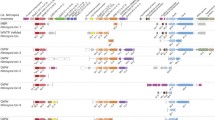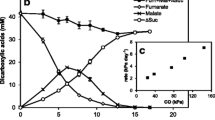Abstract
Nitrosomonas europaea is capable of maintaining an anaerobic metabolism, using pyruvate as an electron donor and nitrite as an electron acceptor; utilization of nitrite depends upon supply of both pyruvate and ammonia. The role of ammonia in this reaction was not determined. N europaea also assimilates CO2 anaerobically into cell material in the presence of nitrite (0.5–1.0 mM), pyruvate and ammonia. This reaction was partially inhibited by nitrite which apparently competed with CO2 for reducing power. Anaerobic “nitrite respiration” is sensitive to ionophores, FCCP being the most effective.
Similar content being viewed by others
Abbreviations
- TCA:
-
trichloroacetic acid
- FCCP:
-
carbonylcyanide-p-trifluoromethoxyphenylhydrazon
References
Abeliovich A (1985) Nitrification of ammonia in wastewater: field observations and laboratory studies. Water Res 19: 1097–1099
Abeliovich A (1987) Nitrifying bacteria in wastewater reservoirs. Appl Environ Microbiol 53: 754–760
Blackburn TH 1983. The microbial nitrogen cycle. In: WEKrumbein (ed) Microbial geochemistry. Blackwell Scientific Publications, Oxford, pp 63–89
Clark C, Schmidt EL (1966) Effect of mixed culture on Nitrosomonas europaea simulated by uptake and utilization of pyruvate J Bacteriol 91: 367–373
Hooper AB (1968) A nitrite reducing enzyme from Nitrosomonas europaea. Preliminary characterization with hydroxylamine as electron donor. Biochim Biophys A 162: 49–65
Kim KR, Craig H (1990) Two-isotope characterization of N2O in the Pacific Ocean and constraints on its origin in deep water. Nature 347: 58–61
Poth M (1986) Dinitrogen production from nitrite by Nitrosomonas isolate. Appl Environ Microbiol 52: 957–959
Remde A, Conrad R (1990) Production of nitric oxide in Nitrosomonas europaea by reduction of nitrite. Arch Microbiol. 154: 187–191
Ritchie GAF, Nicholas JDJ (1972) Identification of the sources of nitrous oxide produced by oxidative and reductive processes in Nitrosomonas europaea. Biochem J 126: 1181–1191
Van der Graaf AA, Mulder A, Slijkhuis H, Robertson LA, Kuenen JG (1990) Anoxic ammonium oxidation: In: Christiansen C, Munk L, Viladsen J (eds.) Proceedings of the 5th European Congress on Biotechnology. Munksgaard, Copenhagen, pp 388–391
Von Korff RW (1969) Purity and stability of pyruvate and 2-ketoglutarate. In: JMLowenstein (ed.) Methods Enzymol, vol. XIII. Academic Press, New York London, pp 519–523
Wood PM (1986) Nitrification as a bacterial energy source. In: Prosser JI (ed.) Nitrification. IRL Press, Oxford, pp 39–62
Author information
Authors and Affiliations
Rights and permissions
About this article
Cite this article
Abeliovich, A., Vonshak, A. Anaerobic metabolism of Nitrosomonas europaea . Arch. Microbiol. 158, 267–270 (1992). https://doi.org/10.1007/BF00245243
Received:
Accepted:
Issue Date:
DOI: https://doi.org/10.1007/BF00245243




